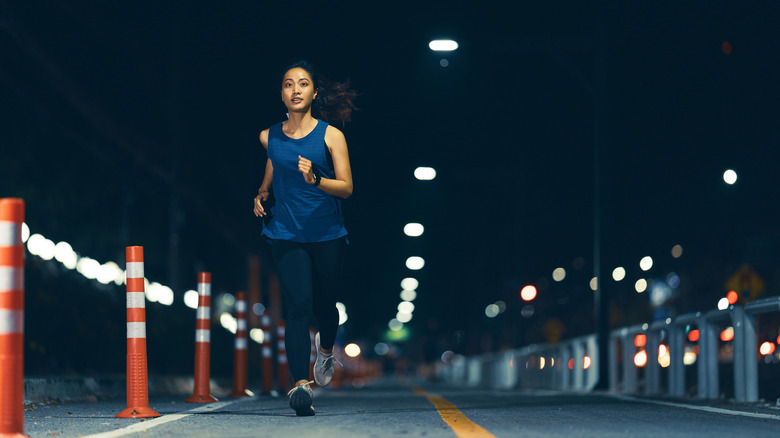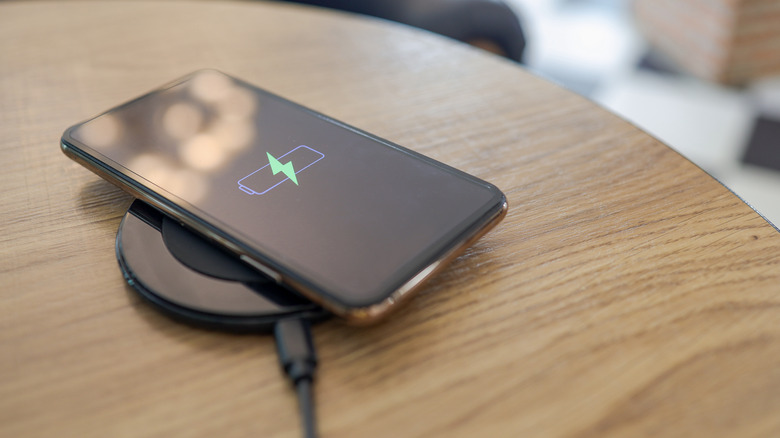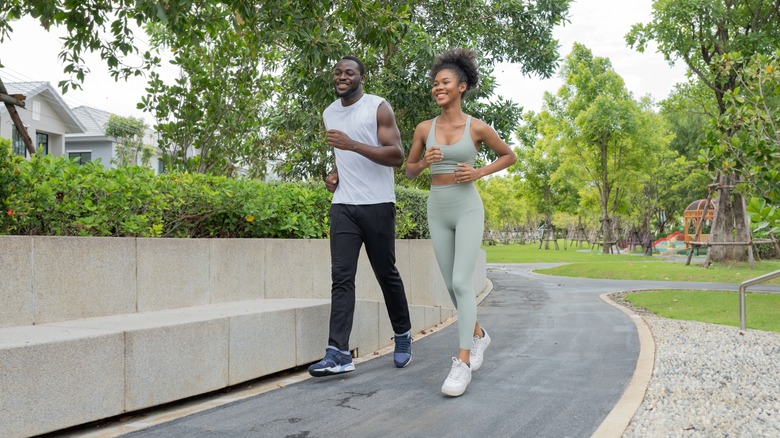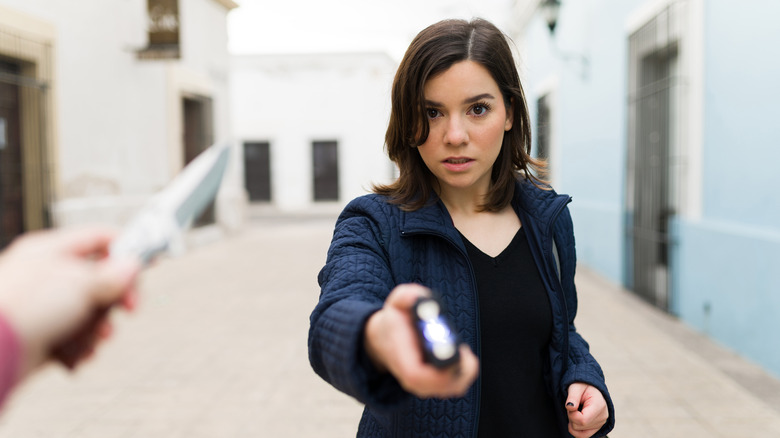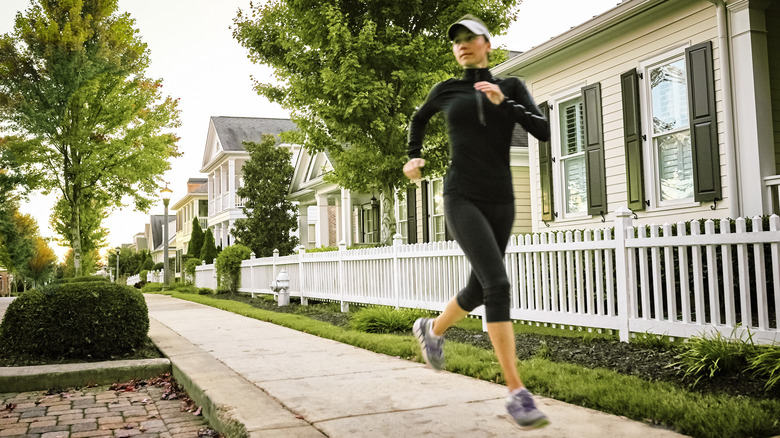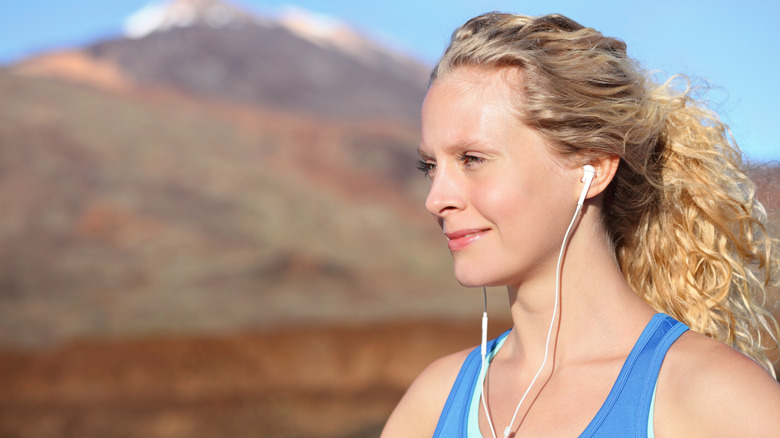6 Tips To Feel Safer When Exercising Outdoors
You have a lot of choices when it comes to where you exercise. You might prefer quick and easy at-home workouts, or getting in your exercise at the gym or a fitness studio, a wellness center, or in the great outdoors. The latter option offers many benefits that indoor options don't, like getting a burst of vitamin D, enjoying beautiful scenery, and having more open space to move around. Unfortunately, though, outdoor exercise could also pose some safety risks.
Whether your favorite outdoor exercise is bicycling, running, or hiking, there's always a chance that something could go wrong. If you're biking, you may get a flat 10 miles from home and have no repair kit with you. If you're running, you may cross paths with someone who doesn't have good intentions. And if hiking is part of your wellness routine, you might get lost, run out of water on a dangerously hot day, or worse.
No, this doesn't mean you should avoid outdoor exercise. It just means you should always use precautions. Sometimes all it takes to prevent dangerous circumstances from occurring is planning ahead and using some good old-fashioned common sense.
Exercise during the day, or in well-lit areas at night
According to statistics compiled by 2017 Open City Crime Data and shared by The Sleep Judge, violent crimes are more likely to occur at night. So unless part of your nighttime workout involves a buddy, try to limit your outdoor hiking, running, power walking (even if for a healthier planet), or bicycling to the daytime hours or to areas that have sufficient lighting at night. Many parks that stay open late as well as neighborhood streets are well-lit, so aim for those areas.
It's also a good idea to bring a bright flashlight if you're on foot or headlights if you're on a bicycle. Check the batteries ahead of time to make sure the flashlight works, and change them if necessary. If the battery is rechargeable, make sure it's fully charged before walking out the door. If you don't own a good flashlight, or there isn't enough lighting where you want to exercise, it's best to work out between sunrise and sunset for your safety.
If you or anyone you know has been a victim of sexual assault, help is available. Visit the Rape, Abuse & Incest National Network website or contact RAINN's National Helpline at 1-800-656-HOPE (4673).
Charge your phone before leaving the house
With all the things they can do, cell phones can literally be lifesavers. For one, they contain built-in GPS receivers that allow you to navigate to thousands of locations all over the world from thousands of starting points. They also offer maps, which can track your movement in real time. And of course, you can call and text your loved ones to provide location or status updates, or to ask for help. Plus, if you happen to lose the cell signal, you can still call 911 from your phone if you need emergency assistance.
Your cell phone is a valuable tool to have when you're away from home, but in order for it to do anything good for you, it needs to have some juice. Make sure it's fully charged, or at least close to it, before venturing outdoors for your workout, even if you don't plan to be outside for long. You can also bring a fully charged portable charger so your phone can charge while you exercise. Having a fully charged cell phone is especially important if you'll be traveling through areas you're not familiar with.
Invite a buddy to tag along
They say there's safety in numbers. This is especially true when you're outdoors and far from home. Although taking a long evening walk alone can be peaceful and great for your mental health, you'll increase the chances of a safe return home if you bring someone with you. Remember the age-old adage "Stranger Danger" and err on the side of caution – if you're jogging through a park downtown, stay on the safe side by working out with a buddy.
Having a friend join you for your outdoor workout can also be beneficial if you were to become injured, whether it's by falling off your bike or twisting your ankle. You might need someone to physically assist you, perform first aid, or help you get back to your car or back to your home. Heat exhaustion is another possibility. Your friend could call 911 if you can't, help you drink water, get you to a shaded area, or provide any other assistance you need to keep you safe.
Know the area, and pack a map
There's nothing more frustrating when you're outside and getting some miles in than realizing that you made a wrong turn and have lost your way. If you're lucky, there will be a public place or people nearby who can guide you to where you want to go, or you'll be able to use your cell phone to get back on track. But if you're not, that outdoor workout may turn into a longer workout than you planned.
To increase your chances of not getting lost, familiarize yourself with the area that you'll be visiting to exercise before leaving your house. You've probably used your phone's map and GPS hundreds of times, but you should also make sure they're working properly ahead of time. It's also a good idea to pull up a map of the area on your phone and take a screenshot.
But, since technology can and often does fail, you may want to go old school and bring a device that doesn't rely on WiFi or batteries to work. So think paper map, compass, etc. These will definitely come in handy if your cell phone battery dies, or worse, if you accidentally drop and break your phone beyond use.
Bring a self-defense weapon
Although you may not have ever felt like your safety was in danger while exercising outdoors, when you're away from home, you can never be too careful, especially if you're a woman. Of the participants surveyed in Runner's World 2017 "Running While Female" survey, 43% of women reported being harassed during their outdoor runs. Bringing a weapon can give you a sense of security when you don't need protection, and serve as a self-defense tool when you do. At the end of the day, it's better to bring a weapon for self-defense and not need it than need one and not have it with you.
What kind of weapon? That depends on what you're comfortable with. A sharp object or a self-defense keychain, ring, or kubaton are good options for your protection. Other effective self-defense tools include stun guns, pepper spray, or mace. You can find many of these items in a small enough size to be discrete, but large enough to do some damage.
Vary your exercise route and time
Many people who run or power walk outdoors on a regular basis tend to choose the same route, over and over again. Some even exercise at the same time of day. Although this may not be avoidable if you have a full-time job with a set schedule, varying your route and workout time can increase your chances of remaining safe.
You never know who's watching you. Someone could be sitting silently on their porch or peering at you through their house or car windows. They might have their own daily routine, which means if it aligns with yours, they'll eventually notice you. If someone who's been watching you intends to bring you harm, it will be easy for them to cross paths with you if they know the route you take and when you take it.
That's why it's important to switch things up. If you run at 7 a.m. on Monday in a big loop around the neighborhood, choose a snake-like pattern through new streets at 6 p.m. on Tuesday. Then, choose a different route the next day. Avoid forming patterns, but be sure you're at least somewhat familiar with the area so you won't get lost.
Make sure you can hear your surroundings
Listening to music, a podcast, or a book with a pair of earbuds can make the time fly by or give you some audible entertainment during your outdoor workout. It can also be a hindrance, though, and even compromise your safety. According to a U.S. study published in Injury Prevention, researchers found 116 cases in which a pedestrian was injured or killed while wearing headphones. More than half of the incidents involved a train, and about 30% of those trains blew their horns.
Accidents involving headphones can also happen with cars, bikes, dogs, and other pedestrians. If you're jogging or riding your bike near busy streets, and you have music blaring in your ears, you may not hear a car honking or the police sirens behind you. If you're on a paved trail, you'll want to be able to hear footsteps, bikes, or a barking dog approaching so you won't get in their way, and so you can react accordingly.
While there's nothing wrong with wearing earbuds or headphones outdoors, it's best to either keep the volume low or keep one ear open so you can hear your surroundings at all times. You may also want to consider using a speaker instead, but out of respect for those around you, it's best to keep the volume low.

